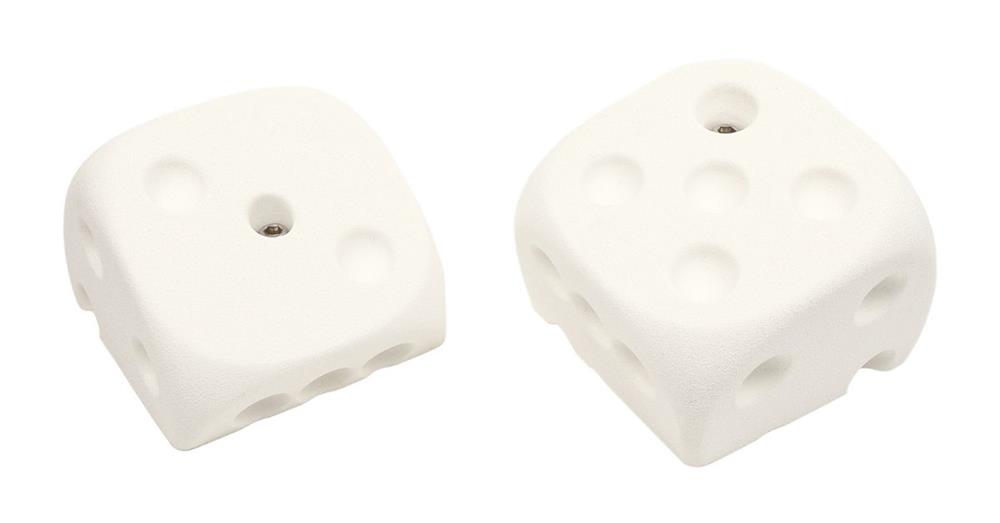Welcome to the exhilarating world of rock climbing, where every hold is a new challenge and every ascent a triumph. Whether you’re scaling indoor walls or navigating outdoor routes, mastering the use of climbing holds is crucial to your success and safety.
Among these holds, slopers present a unique challenge that can test even the most experienced climbers. Below, we’ll explain what climbers must know about slopers, offer tips for using sloper climbing holds correctly, and suggest training exercises to enhance technique and strength.
Understanding Sloper Climbing Holds
Rock climbing slopers are a distinctive type of grip that requires a different approach compared to crimps or jugs. Unlike holds with clear edges or pockets, slopers are round and smooth, providing a minimal surface for your fingers to latch onto. This necessitates a reliance on friction and body positioning rather than pure finger strength.
Slopers come in various shapes and sizes, from bulbous protrusions to slanted surfaces. The key to tackling them lies in understanding their subtle differences and adjusting your technique accordingly. Unlike the more straightforward crimps, your entire hand must engage with the hold, distributing your weight across a larger surface area to maximize friction.
Advice for Handling Sloper Holds
To use sloper climbing holds correctly, we’ll offer some effective tips for hand positioning, grip strength, and body movement.
Keep Hand Open and Relaxed
When approaching a sloper hold, think about how to spread your fingers and palm across the surface. An open-handed grip is essential. Instead of curling your fingers into the hold, splay them out to increase contact with the surface. This technique increases friction and gives you better control over the hold.
Avoid gripping too tightly, as this can cause your hands to tire quickly. Instead, maintain a relaxed yet firm pressure. Visualize your hand as a suction cup that gently adheres to the surface, using friction rather than brute force to stay in place.
Keep Your Body Close and Movements Smooth
Body positioning plays a critical role in successfully navigating slopers. Keep your center of gravity close to the wall to reduce the strain on your fingers and hands. This position allows you to use your entire body to maintain balance instead of relying solely on your grip strength.
When moving between sloper holds, employ smooth and controlled movements. Jerky or abrupt actions can cause you to lose contact with the hold, leading to slips or falls. Practice fluidity in your climbing technique, ensuring that each movement is deliberate and measured.
Attack With a Strong Grip
While sloper holds rely heavily on friction, maintaining a strong grip is still essential. Focus on building overall hand and forearm strength, as these muscles will help you maintain control and stability on slopers. Incorporate grip-strengthening exercises into your training regimen to improve your ability to handle these challenging holds.

Training Exercises
To enhance your technique and grip strength for sloper holds, incorporate specific workouts and drills into your routine. These exercises will help you build the necessary skills and muscle endurance to tackle slopers with confidence.
Hangboard Training
Using a hangboard is an effective way to train for sloper holds. Look for a hangboard with sloper grips and spend time hanging from these holds to build hand strength and endurance.
Start with short hangs and gradually increase the duration as your strength improves. You can also incorporate one-armed hangs to simulate the demands of sloper holds.
Bouldering
Bouldering is an excellent training tool for slopers, providing a more realistic climbing experience compared to hangboards. Look for boulder problems that feature slopers and practice using different hand and body positions to navigate them. As you progress, attempt harder routes with increasingly difficult slopers to challenge yourself and improve your skills.
Finger Rolls
Finger rolls are excellent for developing grip strength. Use a barbell or dumbbell and roll it from your fingertips to your palms and back again.
This exercise targets the muscles in your fingers and forearms, helping you build the necessary strength for sloper holds. Experiment with different weights and reps to find a routine that works best for you.
Open-Handed Hangs
Practice open-handed hangs on a pull-up bar or climbing wall to enhance your grip strength and hand positioning. This exercise mimics the grip required for slopers, which are challenging due to their lack of defined holds.
Begin by hanging for short intervals, focusing on maintaining a relaxed yet firm grip. As you become more comfortable and confident, gradually increase the duration of your hangs. Incorporating this exercise into your routine will improve your grip strength and boost your climbing performance.
Campus Board Training
If you have access to a campus board, use it to practice dynamic movements and grip transitions. Begin by warming up your fingers and forearms with some light exercises to prevent injury. Once warmed up, focus on using open-handed grips and smooth, deliberate movements to navigate the board.
Try different sequences and challenge yourself with varying hold sizes and distances. This type of training will not only enhance your grip strength but also help you develop the skills needed for fluid and controlled climbing on slopers.

Safety Considerations
Safety should always be a principal priority when climbing, especially when using sloper holds. While climbing or training, keep these safety considerations at the top of your mind.
Proper Warm-Up
Before attempting any climb, ensure you perform a thorough warm-up to prepare your muscles and joints. Focus on exercises that target your hands, wrists, and forearms, as these areas will be heavily engaged when using sloper holds. This will help prevent injury and activate your muscles so you can attack your climb with fervor and strength.
Use Chalk
Chalk can significantly improve your grip on sloper holds by reducing sweat and increasing friction. Ensure you apply a moderate amount of chalk to your hands before attempting slopers and reapply as needed throughout your climb. However, use it in moderation, as too much chalk can create a slippery surface.
Controlled Movements
As mentioned earlier, smooth and controlled movements are essential when navigating sloper holds. Avoid abrupt or jerky actions that can cause you to lose contact with the hold. Focus on maintaining a steady pace and deliberate movements to ensure stability and control.
Spotters and Crash Pads
If you’re climbing outdoors or on bouldering routes, always use a crash pad and have a spotter present. Crash pads provide cushioning in case of falls, while spotters can help guide you and prevent injuries. Safety should never be compromised, so ensure you have the necessary equipment and support before attempting challenging routes.
Find Slopers and Other Holds at Atomik Climbing Holds
Mastering sloper climbing holds requires practice, patience, and a deep understanding of technique. Focusing on hand positioning, body movement, and grip strength will enhance your ability to tackle the unique challenge these holds provide.
If you’re looking to add slopers or other climbing holds to your rock climbing wall, Atomik Climbing Holds can help. Our wide selection of climbing holds includes slopers, jugs, pinches, crimpers, footholds, and everything else your wall needs. Browse our inventory and equip your wall with the best holds available today!




Leave your comment